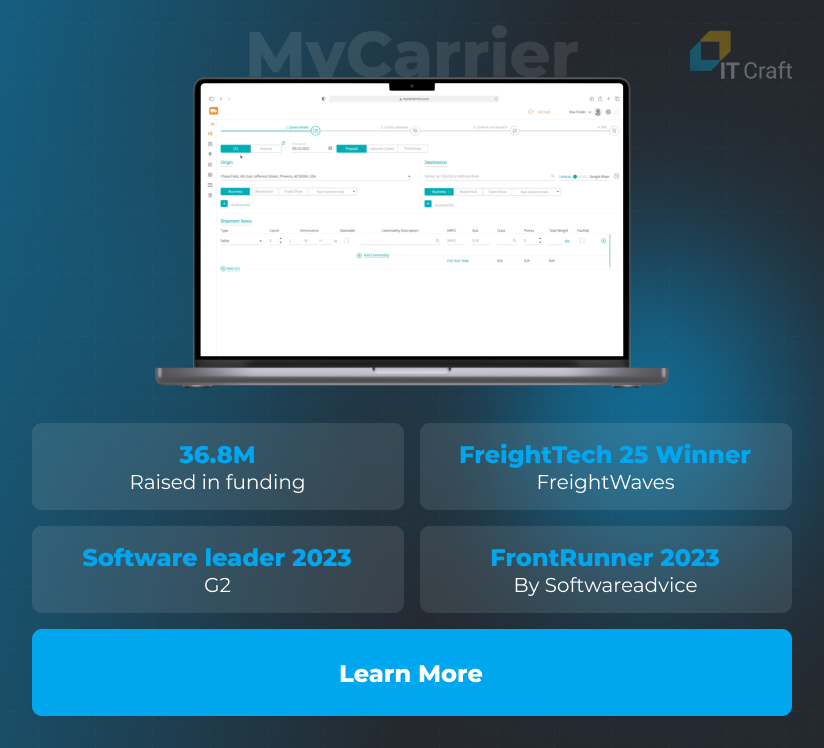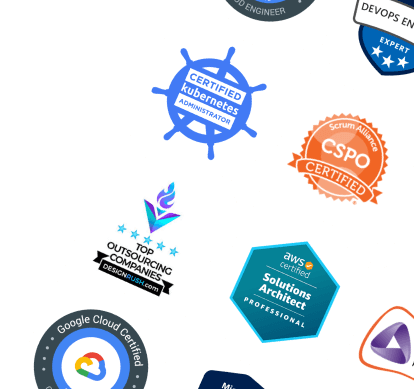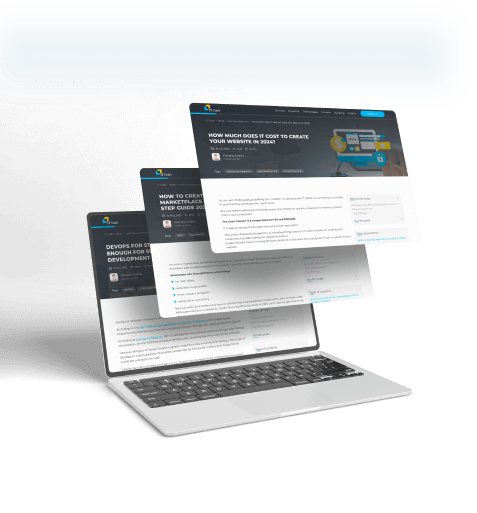Both off-the-shelf AI solutions and custom AI software development become vital for logistics companies as technological adoption remains low and the demand for optimized, digitized, and sustainable operations is high.
Only 25% of respondents who participated in the 2024 tech trends in transportation & logistics survey use AI in their supply chain management — the study was conducted by Here and AWS across three leading economies: Germany, the United Kingdom, and the United States.

Additionally to lack of expertise and internal resources, 8% of all respondents (and 11% from the low progress group) point out that not knowing where to start is a barrier to technology implementation.
Let’s discuss how AI in transportation can help and where a logistics company can start using it today. Below are the top ten use cases, AI in transportation examples, and key trends.
1
Advantages of Using AI in Transportation
Logistics Implementing AI can support one or several business goals, depending on the scale at which a logistics and transportation company integrates AI software into its processes.
Let’s analyze the key benefits of AI in transportation that can lead to increasing the company’s bottom line:

- Enhanced Planning and Forecasts
About 55% of logistics companies plan to implement AI for demand forecasting and inventory management by the end of 2024. AI can calculate handling capacity depending on available vehicles, staff, and space capacity and help adapt when any parameter changes.
An AI transportation system can also improve risk management by analyzing different processes, identifying recurring negative patterns, and forecasting the probability of disrupting events.
AI in transportation and logistics saves businesses money. For instance, in 2022, major logistics companies reached a 27% improvement in route optimization and reduced fuel consumption by 19% by adopting deep learning.
AI automation can also help improve employee satisfaction and prevent burnout, saving indirect costs on recruitment and onboarding new team members.
AI-based automation allows even small companies with a limited workforce to scale operations and complete deliveries on time.
AI can be used to optimize operational tasks, such as order batching and load assigning, route calculation, invoice management, payroll and accounting, and more. As such, AI will increase productivity of logistics companies by 40%+ by 2035.
- High Customer Satisfaction
AI-powered chatbots can work as the first line of customer support 24/7, answering typical questions and helping with basic troubleshooting, and human support can focus on advanced problems.
Also, generative AI can help the marketing team process and summarize customer feedback, which will be the basis for enhancing the company’s services and planning marketing campaigns.
Do you want to enhance customer support with an AI chatbot?
Let’s discuss your needs and estimate training and integration costs. It’s free!
Contact Us
- Increased Supply Chain Visibility
Supply chain visibility is the top three priority in logistics. AI can help analyze the incoming data on traffic, weather, and route alternatives in real time and suggest route optimization in response to changing conditions, knowing where cargo is.
Companies can also integrate AI into IoT solutions for asset tracking to automatically monitor various items’ locations en route and inside a warehouse, decreasing search and update time.
Integrating AI can boost sustainable logistics and reduce negative environmental impact. AI can help track vital sustainability metrics and define measurable sustainability goals.
AI solutions are an integral part of the green logistics market, which is projected to reach $2.47t by 2030, from $1.3t in 2022. AI-based planning can help companies detect bottlenecks and refine environmental goals. Companies can use demand forecasting, route optimization, and enhanced supply chain operations to minimize waste and decrease carbon footprint.
2
AI in Transportation: Top Ten Use Cases
AI is often associated with futuristic artificial intelligence transportation solutions, such as self-driving vehicles, drone taxis, and smart cities, where traffic is managed automatically and requires minimal human supervision. These concepts still seem to belong in the future.
However, many practical use cases exist when logistics companies can benefit from implementing AI for transportation today. Here is IT Craft’s list of the top ten use cases:

Real-Time Tracking
According to the 2024 tech trends in transportation & logistics survey mentioned above, real-time tracking is the most valuable feature for transparent supply chain management, for which basic and AI-enhanced data analytics are used.
AI aggregates GPS data and combines it with driving conditions, traffic load, and historical driving data to:
- calculate vehicle location and speed in real-time
- forecast its arrival time
- understand a vehicle’s whereabouts and make an informed decision about (re-)routing
- assess driving performance and provide immediate feedback
- update customers on delivery time
Real-time AI tracking can help coordinate the entire fleet and optimize the wait and vehicle load/unload time in a busy logistics hub.
Demand Planning
AI enables transportation companies to streamline demand forecasting, which results in optimized use of available capacities:
- fleet – optimize using of available vehicles and maintenance planning
- workforce – understand how many workers the company needs at a certain time to evade over- and understaffing
- space – identify required stock levels to ensure the right available capacity at the right time
AI software can process internal data, trends, and news to identify risks of possible disruptions that can affect customer sentiments and lead to lower sales.
How is AI used in transportation for demand planning? It highlights trends based on available historical data/patterns and drafts a response plan. As a result, companies can increase customer satisfaction and improve their market position.
Inventory Management
AI can boost several aspects of inventory management:
- Use collected data for process optimization, e.g., improve warehouse utilization by calculating the best indoor routes
- Monitor real-time data to alert on various events, e.g., low supplies, vehicles en route, or expiry dates of perishable items
- Automate data entry, data exchange with other departments, and routine managerial operations such as reordering or return handling to optimize workload and minimize errors
- Prepare for spikes in customer demand and fluctuations in customer behavior
AI can process data on supplier performance, helping the company evaluate each supplier’s stability, strengths, and weaknesses and select the best fit for each specific order.
Route Optimization
Route optimization is one of the most in-demand features when using AI in transportation and logistics. AI can calculate a route by considering multiple parameters, such as planned stops, traffic density, road restrictions, allowed work time, and more.
More importantly, AI can recalculate the route quickly when itinerary details change unexpectedly (e.g., emerging traffic congestion caused by a traffic accident), helping drivers and dispatchers avoid idle time.
Transportation companies can also integrate AI into indoor navigation software to optimize routing inside warehouses. For instance, AI can alert immediately when an order goes to the wrong place or minimize search time for lost items.
Fleet Management
Companies can integrate AI in transportation software to improve scheduling. AI can help find the right carrier for each load based on load type, weight, availability, rates, etc.
AI can help coordinate the available fleet while processing load/unload time, arrivals, driver shift preferences, etc., to reduce idle and dwell time. Such functionality lets companies reduce costs and increase driver satisfaction.
AI can also enhance operational efficiency by planning and tracking maintenance in the schedule to prevent breakdowns and downtime. It can work preventively while checking driver behavior against weather conditions, traffic data, and best patterns and providing suggestions to improve safety.
Communication within Supply Chain
AI can improve collaboration while streamlining information search, exchange, and sharing. It can recognize images of documents such as invoices or fulfillment orders, retrieve key information, and add it to the CRM or exchange it with partners.
AI can generate reports based on retrieved information and send them to designated users, saving time on coordination between departments of two different companies or decreasing preparation time for a meeting.
An AI-powered search engine can look for missing information through different communication channels, including chat messages, attached files in email boxes, or transcripts of online meetings, which can help answer requests quickly.
Customer Service
An AI chatbot can replace a lengthy search while providing website visitors with conversational answers. It can also serve as the first line of customer support to solve common issues or provide automated translation to help the support team communicate with international customers.
To provide customers with relevant answers, a transportation company will likely need to train the selected AI model on the company’s data, which enables the chatbot to generate company-specific data.
Ease of integration and customization are also important; the chatbot must have a branded design and feel like a part of the company’s services, working seamlessly on user devices.
Parking Management
This artificial intelligence transportation functionality is related to planning and inventory management functionality. It aims to increase the efficiency of a company’s fleet. For companies, AI can forecast parking demands and distribute space optimally in the company’s parking lot.
Also, an AI parking management system can quickly check available spots and prices and reserve a place if necessary while routing drivers to the parking lot. It can pay drivers automatically or share payment details with the company to facilitate reimbursement.
Also, AI can consider alternative routes with the least expensive parking prices or plan for routes during off-peak times, optimizing parking costs.
Connected Vehicle
Drivers can use AI-powered assistants to receive alerts on potential hazards, such as a rapidly approaching scooter rider, thus increasing road safety.
To do this, artificial intelligence in transportation and urban mobility relies on computer vision, LIDAR sensors, cameras, and IoT devices to collect road information, which the AI software processes in real time.
AI can detect a driver’s fatigue and overall state and encourage the driver to make a stop. It can assess the driver’s emotional state, which can lead to speeding or reckless driving, and alert the driver of distractions.
Voice assistants can also prevent distractions by enabling drivers to do activities without taking their hands off the wheel, e.g., tailor climate control. They can also entertain drivers to help them remain concentrated.
Traffic Management
Traffic optimization remains a problem as people return to offices and the number of car trips continues to grow to pre-pandemic levels. In particular, US drivers lost 42 hours on average in congestion in 2023, which cost the US $70.4B.
One of the solutions is using AI in public transportation to reduce idle time and emission volumes by identifying traffic patterns and recommending flow optimization or even optimizing the light switching in real time to decrease congestion time.
Transportation companies could join the initiative and integrate information on traffic lights into route planning. They could also connect route planning software to traffic management systems via an API to optimize real-time routes.
3
Six Significant AI in Transportation
You have probably already wondered: “What is an example of artificial intelligence in transportation?”
Let’s examine how organizations are already using artificial intelligence in the transportation industry to enhance various processes and solve real-life problems.
Here are five remarkable examples:
Uber Freight
Uber has launched Insights AI in transportation to optimize shippers’ decisions. The software can generate outcomes based on 45 data points, provide reports on trends across transportation markets, offer benchmarks for relevant peer groups, and more.
Green Light
Green Light is Google’s global project that can potentially decrease stops by 30% and greenhouse gas emissions by 10% by using AI and Google Maps driving trends for coordinating intersections.
Seattle is the first North-American city to test the technology for improving traffic flow.
Zoho AI Modeler
Zoho AI modeler offers artificial intelligence logistics transportation functionality for several use cases. Workers can calculate the probability of customer wins, identify assets, extract text from images and PDFs, analyze sentiments in feedback, and automate invoice processing.
Upper
Upper uses AI to plan and optimize routes and improve dispatching. It allows users to adjust routes for multi-stop deliveries while requiring little to no tech skills, saving both drivers’ and dispatchers’ time. It also provides real-time tracking to increase the visibility of the delivery process.
Logivations
Logivations focuses on scan-free warehouse management and real-time tracking of items and transporters. It recognizes objects with the help of cameras and AI. The software also uses collected data to provide insights on warehouse traffic, bottlenecks, and idle time and to enhance safety.
Logility
Logility Solutions has integrated AI for transportation to help users increase supply chain visibility. Also, there is more. DemandAI+ enhances demand forecasting and enables users to get answers in real time, and InventoryAI+ helps reduce carrying costs.
4
Future of AI in Transportation
AI technologies can make a safe, efficient, and sustainable future for transportation companies and their customers.
The key areas where AI and transportation remain a perfect match include:

Supply chain visibility
The emphasis is on improving real-time supply chain visibility, where the positive impact of technology on transportation translates into improved quality. While progress was achieved for truck operations, sea and air deliveries are hard to predict and track and require AI.
Fleet maintenance
Vehicle maintenance is another crucial use case that is not widespread now but is poised to become ubiquitous. AI can analyze vehicle historical performance and combine it with data from sensors installed on important parts and units to alert in upcoming maintenance works.
Autonomous vehicles
Startups continue working on AI transportation, using self-driving vehicles that can perceive the environment and make driving decisions without human assistance. The aim is to decrease congestion and improve road safety.
Smart traffic management
Traffic distribution and bottleneck management will become efficient as smart lights are implemented at scale, and AI will manage the network automatically, ensuring seamless synchronization within a smart city.
Indoor navigation and tracking
Positive impacts of transportation technology include automated warehouse navigation to build optimum routes and layouts and track items through various methods, including object recognition, RFID, QR codes, and BLE beacon tags.
Sustainable transportation
As a result of the further adoption of AI in transportation to optimize routes and schedules, companies will reduce fuel consumption and resource waste, increasing the eco-friendliness of provided services. Using electric vehicles with smart charging from renewable sources will also increase sustainability.
Are you looking for a business-focused team?
Let’s schedule a call and discuss how we can help you reach your business goals through AI implementation.
Contact Us
5
IT Craft’s AI Development Services
IT Craft offers AI development and consulting, including ChatGPT development and integration services, to help our clients achieve sought-after operational efficiency and maximize the positive impact of technology on transportation.
IT Craft’s AI engineers focus on finding and customizing a solution for the business problem and integrating it into your workflow:
- predictive analytics for business planning,
- AI-driven insights,
- workflow automation for streamlined,
- custom report generation,
- smart asset tracking,
- customer support through AI chatbots,
- and more.
You can select from a variety of provided AI services, including
- artificial intelligence consulting
- feasibility evaluation
- data engineering & architecture
- predictive analytics & modeling
- model fine-tuning
- custom AI software development
- AI software integration via API
- AI security
- AIOps
- and beyond
These services are essential for assessing your needs, delivering relevant software, keeping your system running, and evading possible disadvantages of AI in transportation.
MyCarrier
MyCarrier is a transportation management system that seamlessly connects carriers and their customers within a transparent and efficient workflow.
The client needed:
The client had vision of a system for effective management of LTL shipments for both transportation companies and their customers.
How we helped:
The IT Craft team delivered an MVP for the client requirements, helping launch the product within the expected timeline. The team worked on feature expansion to FTL shipments and efficient software scaling.

!
Summary
Although the use of AI in transportation is rather low, as mentioned in the introduction, companies should keep in mind that they might only win the surging competition in the near future if they invest in AI-powered software.
There are at least ten use cases where AI can increase a transportation company’s bottom line today, helping establish efficient, agile, and sustainable operations. Those sitting on the fence should reconsider their AI strategy to maximize the positive impacts of transportation technology.









